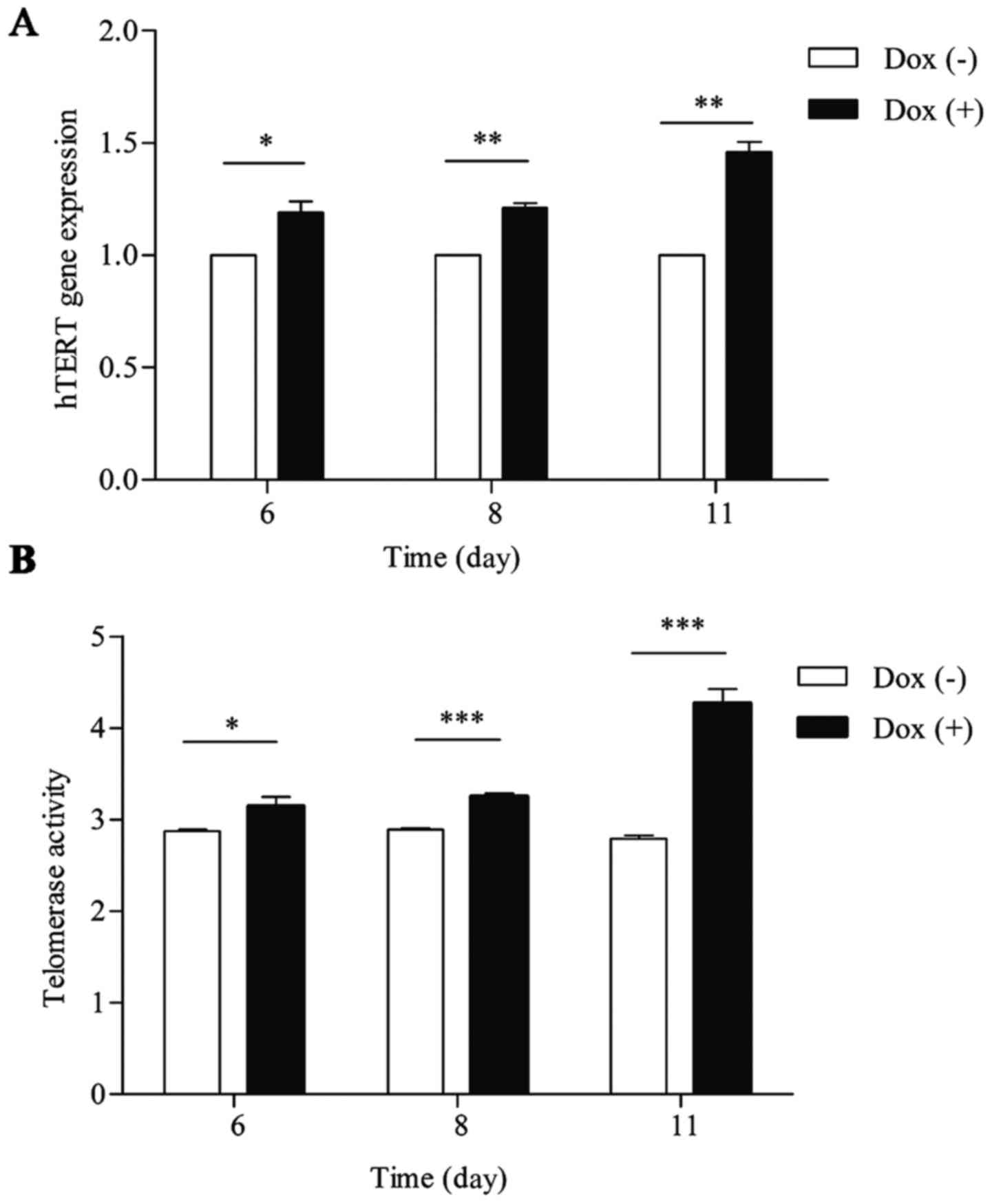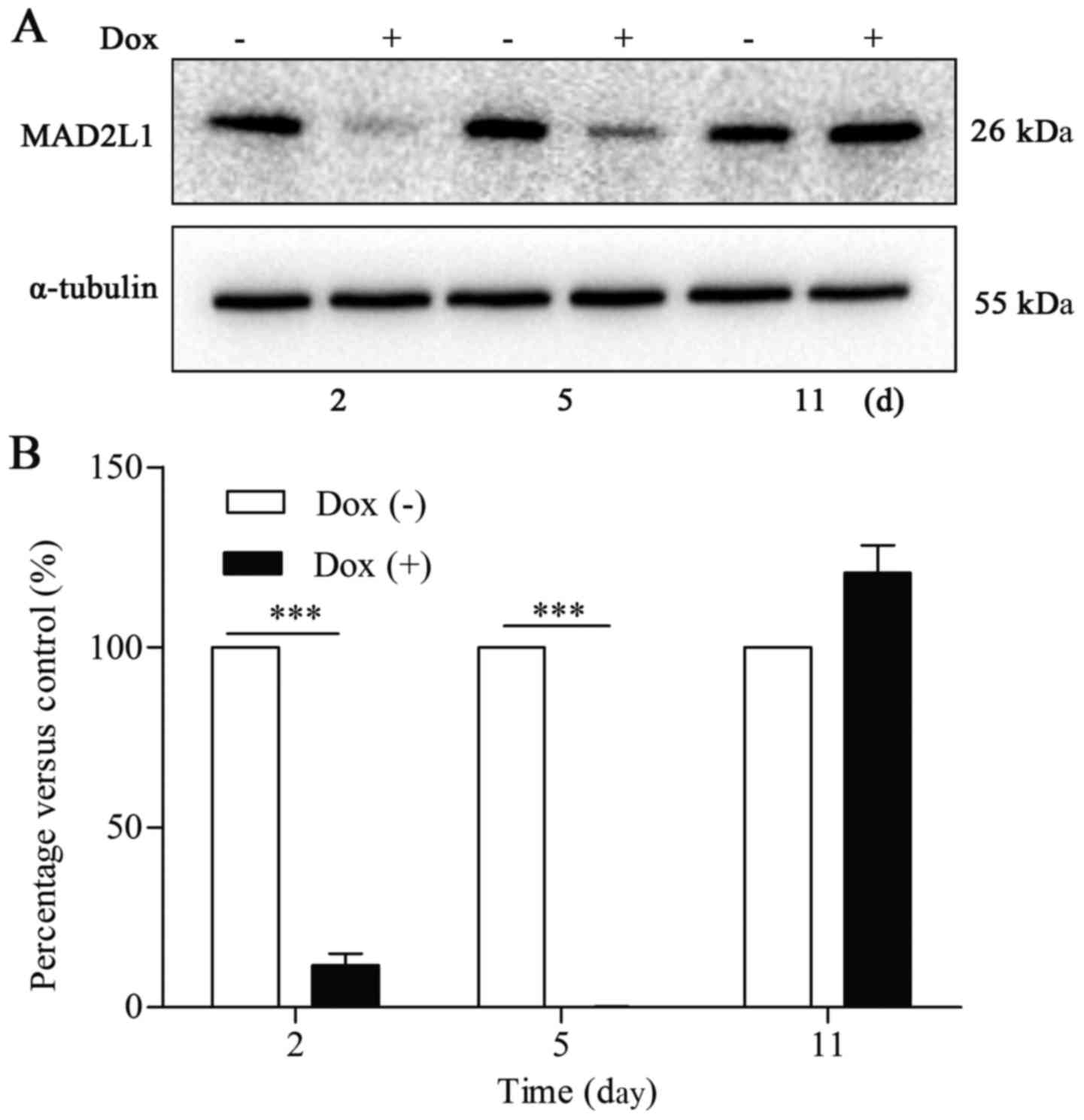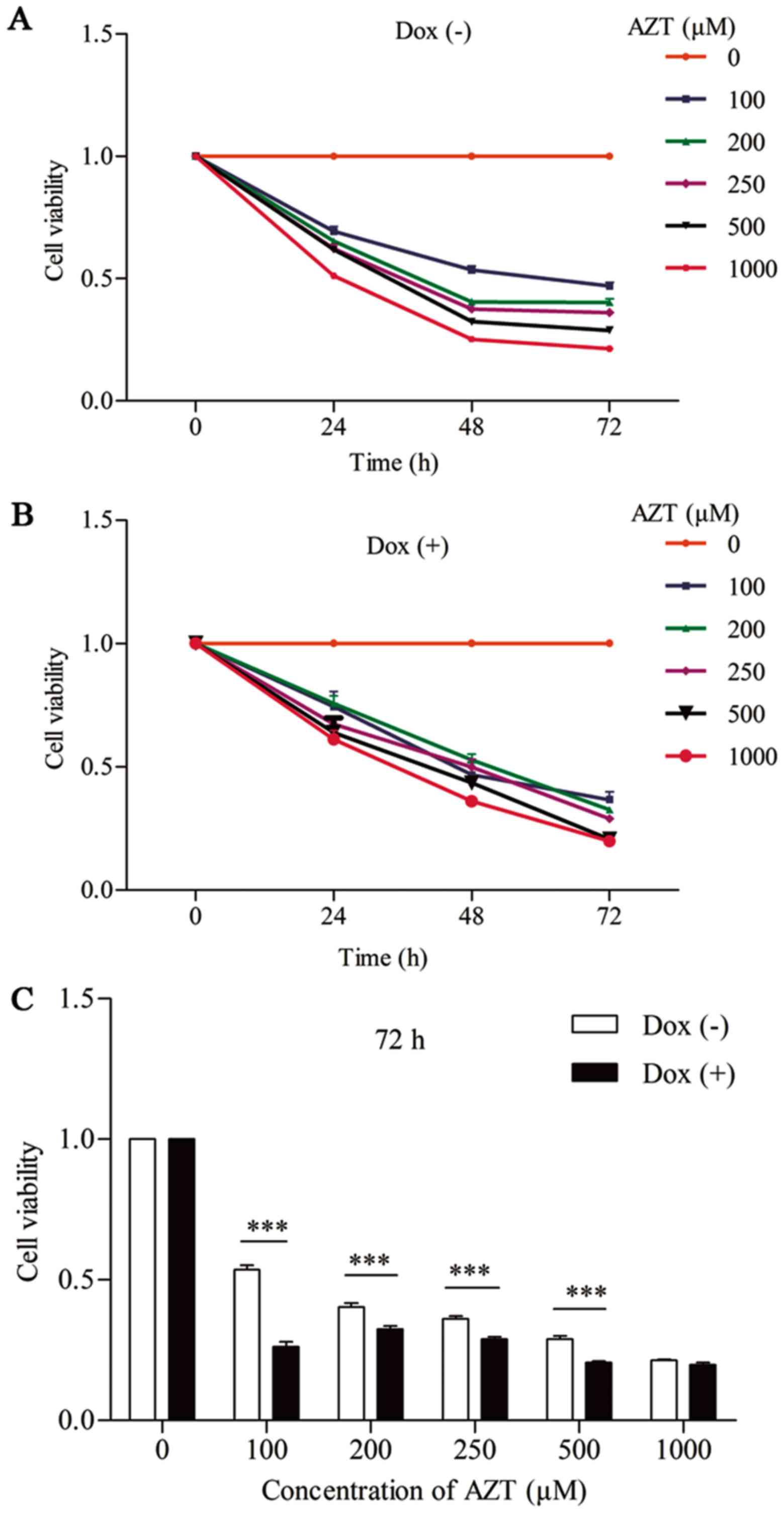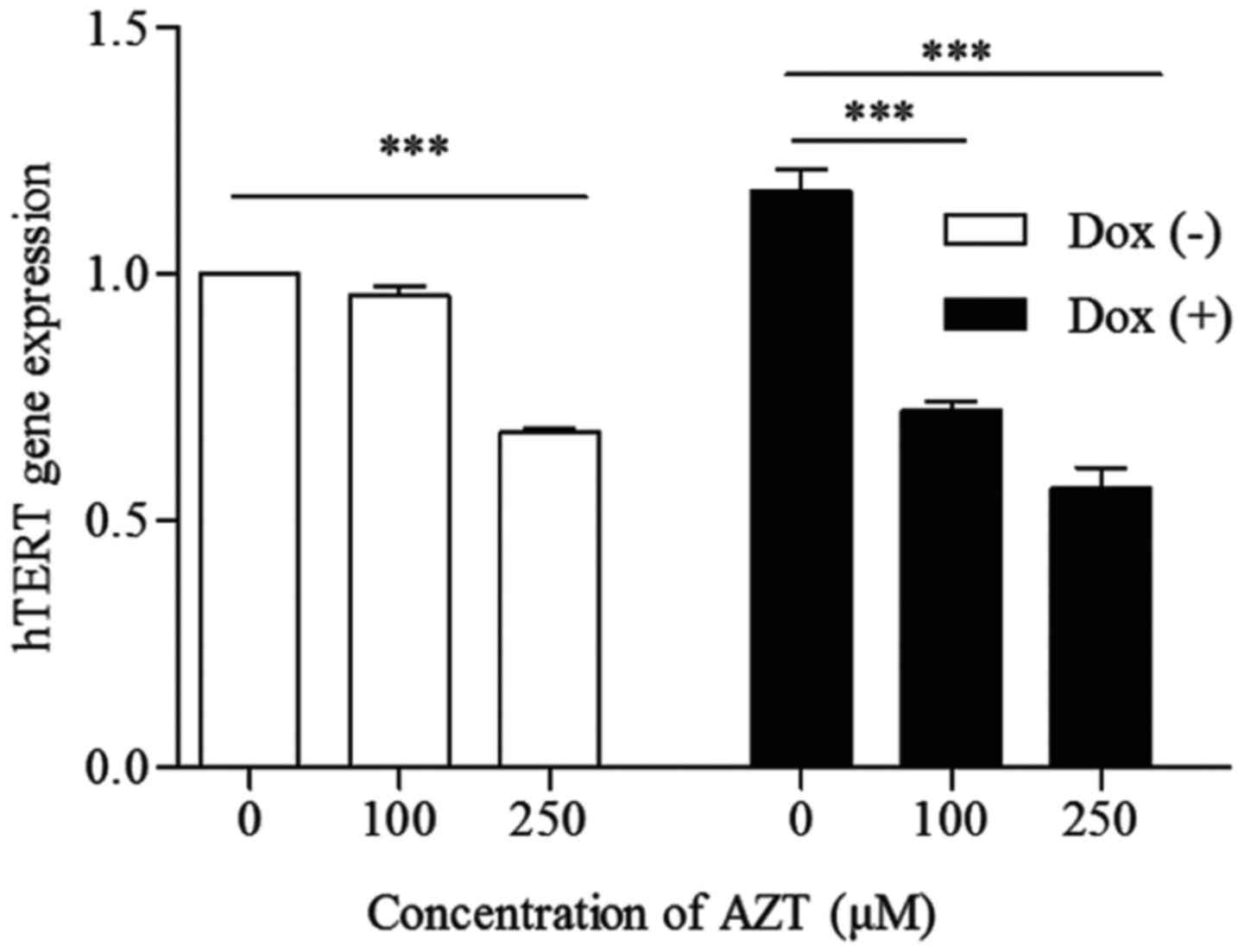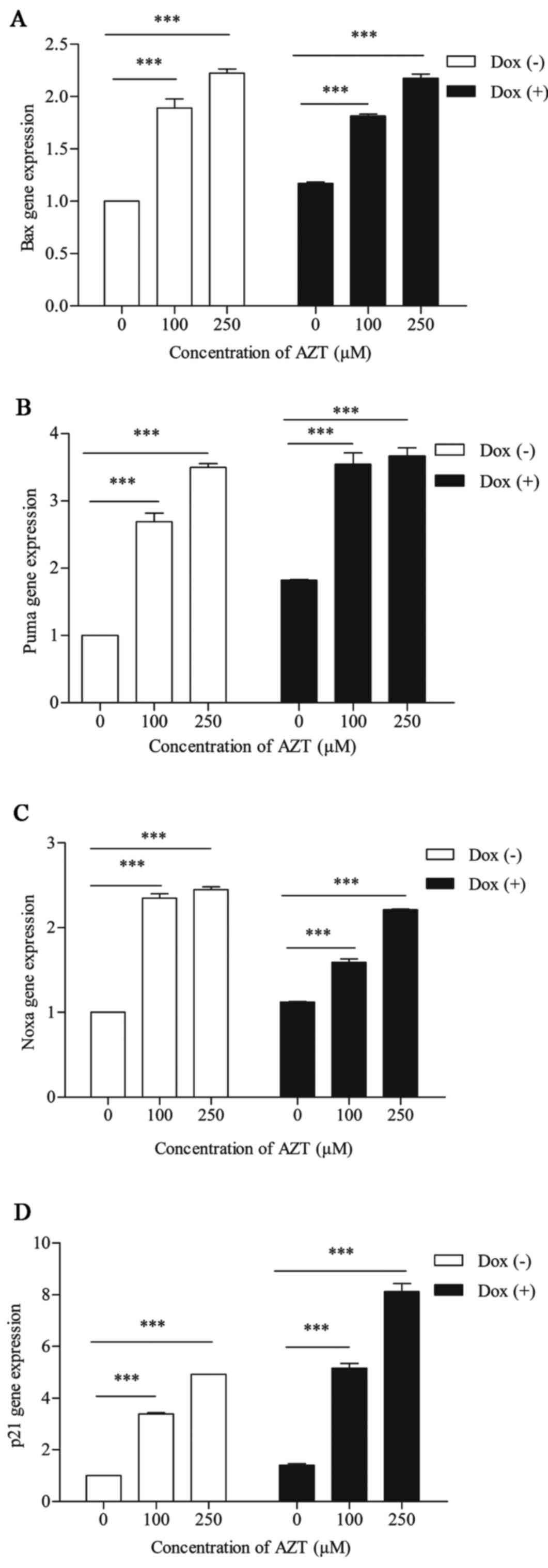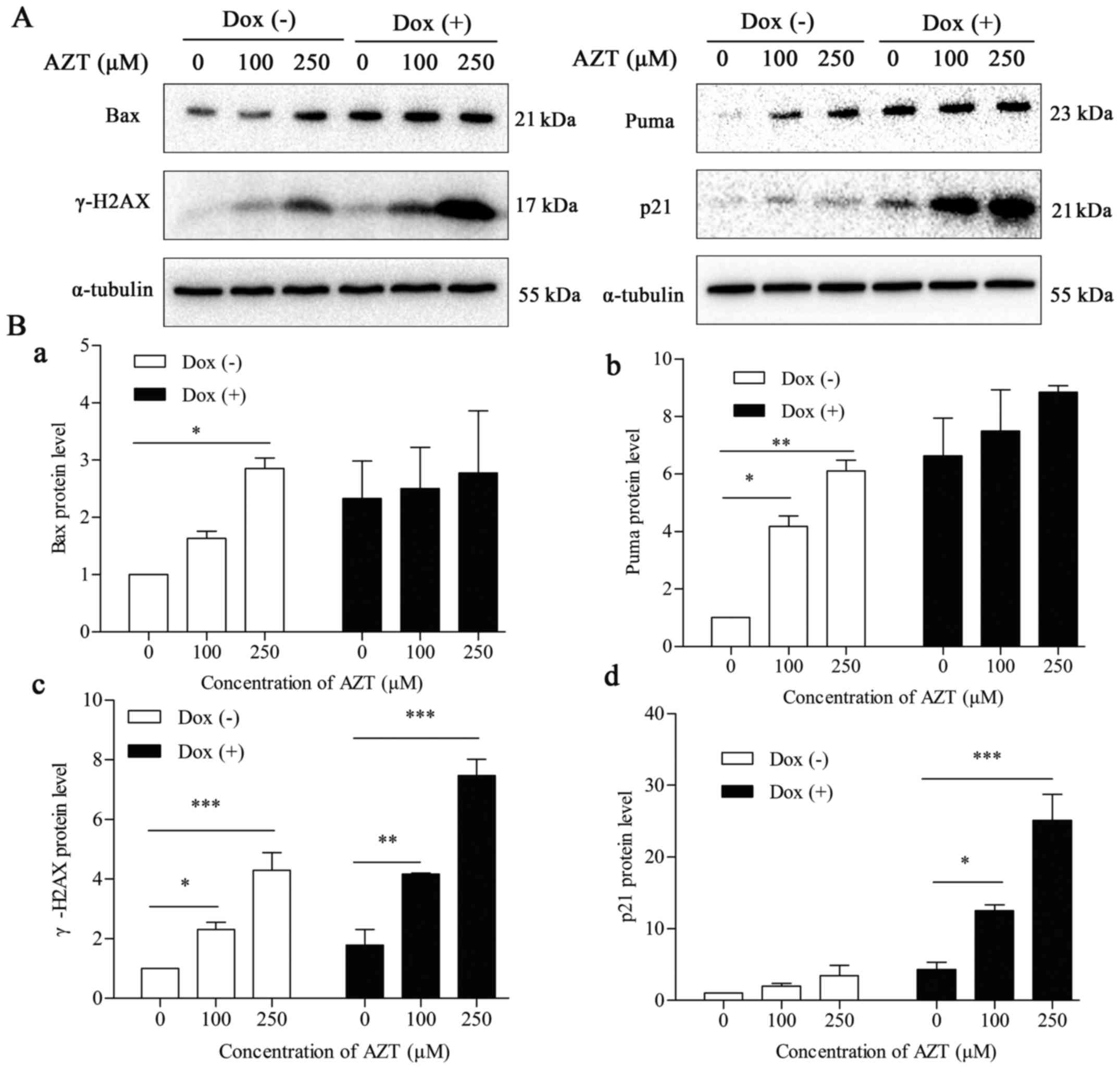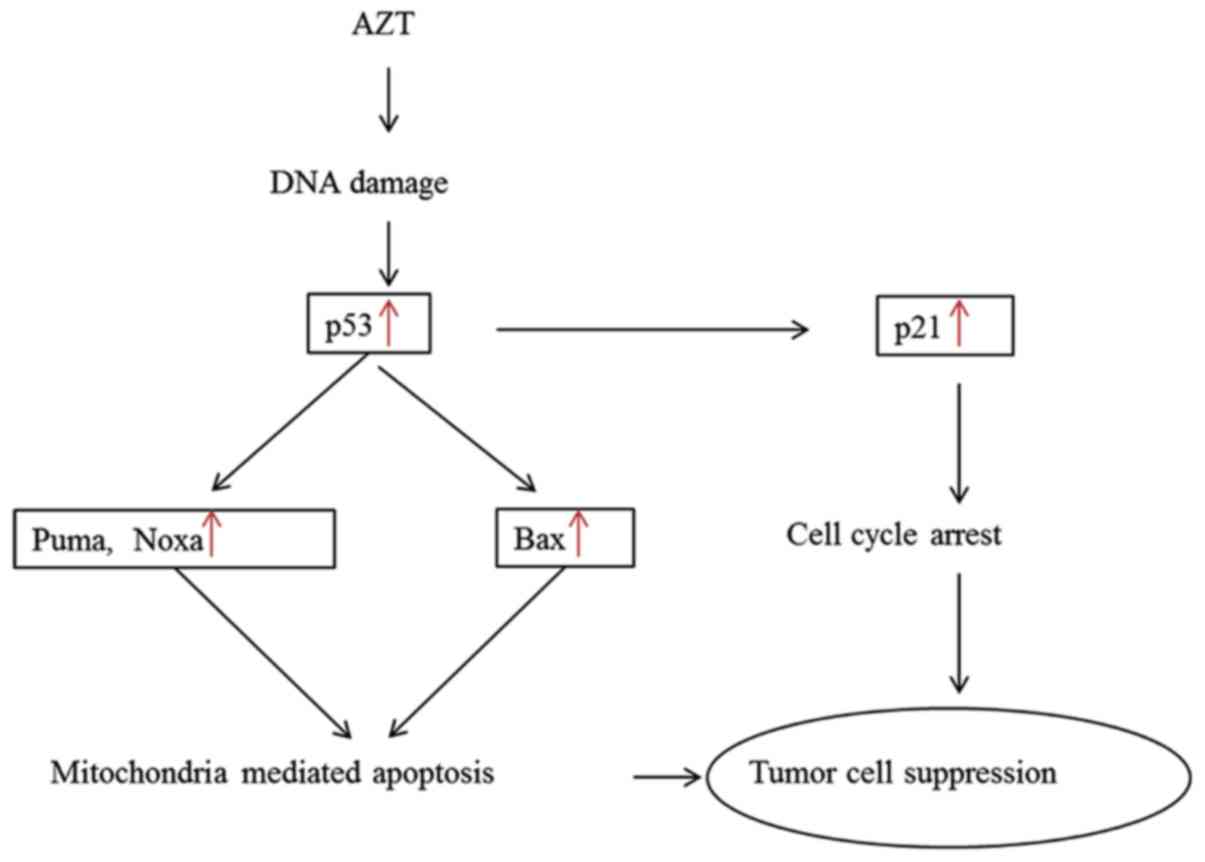Differences in telomerase activity and the effects of AZT in aneuploid and euploid cells in colon cancer
- Authors:
- Published online on: June 14, 2017 https://doi.org/10.3892/ijo.2017.4043
- Pages: 525-532
Abstract
Introduction
Telomeres are linear structures that are located at the end of eukaryotic chromosomes performing important functions during chromosome integration and stability (1,2). In somatic cells, which lack telomerase, the length of a telomere is constantly being shortened by the process of cell replication. Telomerase, a ribonucleoprotein enzyme that is comprised of telomerase reverse transcriptase (hTERT) and an RNA subunit (TERC) in addition to other proteins that control telomerase activity to prevent telomere shortening (3,4). It has been confirmed that hTERT overexpression plays a key role in the initiation of unlimited proliferation during oncogenesis and that introducing hTERT into epithelial cells and fibroblasts conferred infinite replicative potential (5–7). Moreover, overexpressing hTERT has been shown to be associated with advanced invasive tumor progression and worse prognoses (8–10). Currently available data demonstrate that >90% of malignant tumors express high levels of telomerase activity, while normal and benign tissues do not with the exception of lymphoid cells, hematopoietic cells and germ cells, which possess proliferative potential (11,12). These data indicate that telomerase might be useful as a molecular marker of tumors in a wide range of applications.
A primary phenotype of cancer is aneuploidy (13–16). Aneuploidy refers to any deviation from a normal number of chromosomes that results from a whole-chromosome gain or loss in a cell. Aneuploidy is generally caused by mitotic errors that occur as a result of a deficiency in one of the mechanisms, such as the spindle assembly checkpoint (SAC) (17–19), that are involved in ensuring that chromosomes segregate correctly. In humans, aneuploidy is harmful because it can cause some congenital malformation syndromes, spontaneous abortion and stillbirth. More than 90% of solid tumors and 50% of blood tumors are aneuploid (20). Although aneuploidy is observed in most human cancers, the functional roles of aneuploidy during tumor formation remain poorly understood. In mice and humans, a majority of autosomal trisomies and monosomies are detrimental to organismal survival (21), and it has been demonstrated that aneuploidy blocks cellular proliferation, spontaneous immortalization and survival (22). In contrast, because of its passive effects on cell immortalization and viability, aneuploidy is a hallmark of cancer cells (13). A recent bioinformatics analysis showed that the number of genes that can prompt tumorigenesis is higher than was previously thought and that aneuploidy may contribute to the development of the complexity of tumor genomics that affect multiple tumor-driving genes (23). Genetic studies performed using mouse models have provided experimentally based evidence showing that mutations in genes that regulate chromosome segregation initiate carcinogenesis by inducing the loss of heterozygosity (24). However, the influence of this loss on tumorigenesis is context-dependent, and aneuploidy was found to repress carcinogenesis in some mouse strains (25). Studies performed in yeast have identified genes that affect cell survival in the presence of aneuploidy. The survival factors associated with aneuploidy in human cells in addition to their functions in cancer formation remain to be determined. It was previously shown that the survival of aneuploid cells is limited by ATM/p53-dependent DNA damage checkpoints (26). Telomerase was found to function as an aneuploidy-associated survival factor that abrogated aneuploidy-induced DNA damage responses, premature senescence and cell depletion by alleviating telomere replication stress (27).
Telomerase-targeted therapies for tumors is receiving an increasing amount of attention, but substantial progress toward a clinical treatment involving telomerase has not been achieved. Azido-deoxythymidine (AZT) is a type of nucleoside analogue that is approved by the Food and Drug Administration to treat acquired immune deficiency syndrome (AIDS). AZT inhibits DNA double-strand formation by destroying the RNA reverse transcriptional ability of the virus, which results in the loss of the replication template and a consequential decrease in the replication rate (28–31). AZT has been shown to inhibit telomerase activity in a variety of cancer cells, including colon, human brain glioma and liver cancer cells (32–34).
It is clear that telomerase and aneuploidy play important roles in tumor development. In the present study, we demonstrate that telomerase activity and the expression of hTERT were higher in aneuploid than in euploid cells. In addition, we found that the telomerase inhibitor AZT inhibited cell proliferation and induced apoptosis and cell cycle arrest in both aneuploid and euploid cells via the downregulation of hTERT gene expression.
Materials and methods
Cell lines and lentiviral transduction
The human colorectal cancer cell line HCT116 was obtained from the Institute of Basic Medical Sciences, Subei Peoples' Hospital. To generate HCT116-shRNA-MAD2 cells, a short-hairpin RNA (shRNA) that targeted human MAD2 was cloned into the pInducer10-MirRP lentiviral vector. The shRNA-containing plasmid was then packaged in lentiviral particles at the Vector Core. Lenti-PuroEMPTY-VSVG was used as the background control. A total of 1×106 cells/10-cm plate were transduced for 48 h with cell supernatant containing a lentivirus that was diluted in fresh serum-free medium at a ratio of 1:1. Stable cells were selected by incubating the cells with 10 µg/ml puromycin at 37°C for 3 weeks. The cells were maintained in Dulbecco's modified Eagle's medium (DMEM; Gibco, Carlsbad, CA, USA) supplemented with 10% FBS (Sigma-Aldrich, St. Louis, MO, USA), 100 IU/ml penicillin-streptomycin and 2 µmM L-glutamine at 37°C in a humidified atmosphere containing 5% CO2.
The formation of aneuploidy
We used a doxycycline-induced program to conditionally knock down MAD2, resulting in HCT116-shRNA-MAD2 cells. The HCT116-shRNA-MAD2 cells were divided into two groups: one group was cultured in 0.2 µg/ml doxycycline-supplemented medium for 16 h (referred to as Dox (+) or aneuploid cells) to conditionally knock down MAD2 (HCT116-shRNA-MAD2 cells), and the other group was cultured in non-doxycycline medium and used as the control group (referred to as Dox (−) or euploid cells). HCT116 is a human colorectal cancer cell line that is chromosomal number-stable and has a near diploid karyotype.
Metaphase spreads
At 11 days after the doxycycline washout was performed, cells at 70~80% confluency were treated with 80 ng/ml of the mitotic inhibitor nocodazole (Sigma-Aldrich) and 10 µM of the protease inhibitor MG132 (Selleck Chemicals, Houston, TX, USA) and then incubated for 6 h at 37°C. The cells were then treated with a hypotonic solution (0.01 M sodium citrate and 0.03 M KCl) at 37°C for 15–20 min and fixed 3 times in Carnoy's fixative (methanol:acetic acid, 3:1) that was pre-cooled on ice. The cells were subsequently spread on glass slides that were pre-cooled at −20°C. Metaphase cells were stained using Giemsa (Beijing Solarbio Science and Technology Co., Ltd., Beijing, China), and chromosomes were counted under a fluorescence microscope for the chromosome counting analysis. Cells with any number of chromosomes other than 45 or 46 were defined as aneuploidy [the chromosome karyotype of the HCT116 cell line showed that the stem line chromosome number is near diploid with a modal number of 45 (62%) and polyploid at 46 (6.8%) according to the ATCC].
Western blot analysis
Total proteins were extracted using cell lysis buffer from cells placed on ice and then quantified using a Bradford protein assay. Equal amounts of cellular proteins (60 µg) were separated using 10% sodium dodecyl sulfate (SDS)-PAGE according to the manufacturer's instructions (Beyotime Institute of Biotechnology, Shanghai, China). The resolved proteins were then transferred onto polyvinylidene difluoride (PVDF) membranes (Millipore, Billerica, MA, USA). The membranes were incubated in 5% fat-free milk or 5% BSA in 1X TBS containing 0.1% Tween-20 (TBST) at room temperature for 2 h and then probed with the following specific primary antibodies: MAD2L1, AF4005 (1:200, R&D Systems, Minneapolis, MN, USA), α-tubulin (1:2,000, Vazyme Biotech Co., Ltd., Nanjing, China), Puma, ABC158 (1:1,000; Millipore), Bax, AB2915 (1:1,500; Millipore), p21, MABE325 (1:1,000; Millipore), γ-H2AX, or 05–636, (1:400; Millipore) overnight at 4°C. After the membranes were washed 3 times with 1X TBST, they were incubated with horseradish peroxidase (HRP)-conjugated secondary antibodies (1:3,000; Millipore) at room temperature for 90 min. Reactive bands were visualized using a chemiluminescence detection system and analyzed using Image Lab software.
Telomerase activity
Telomerase activity of cells was quantified using a TeloTAGGG Telomerase PCR ELISA kit (Roche Diagnostics GmbH, Mannheim, Germany) and a process called Telomeric Repeat Amplification Protocol (TRAP) based on the protocol described by Kim et al (35). A total of 2.5×103 cells were harvested from each sample for the PCR reactions. The negative controls samples were heat-treated for 5 min at 95°C to inactivate telomerase activity. The positive control was provided by the kit. The following PCR program was run in a Thermal cycler: one cycle of 25°C for 20 min and 94°C for 5 min, 30 cycles of 94°C for 30 sec, 50°C for 30 sec, and 72°C for 90 sec and one cycle of 72°C for 10 min. The PCR products were subsequently analyzed using ELISA, and telomerase activity was obtained by determining the absorbance at 450 nm (with a reference wavelength of 690 nm). The relative telomerase activities (RTA) of various samples were determined using the following formula: RTA = [(AS-AS,0)/AS,IS/]/[(ATS8-ATS8,0)/ATS8,IS] × 100, where AS, absorbance of the sample; AS,0, absorbance of the heat-treated sample; AS,IS, absorbance of the Internal Standard sample; ATS8, absorbance of the control template; ATS8,0, absorbance of the lysis buffer; and ATS8,IS, absorbance of the Internal Standard control template.
Cell viability measured by CCK-8 assay
To investigate the effect of AZT (Sigma-Aldrich) on cell viability, both groups of cells were subjected to CCK-8 assays. Briefly, the cells were seeded in 96-well culture plates at 4×103 cells/well and treated with one of a variety of concentrations of AZT (i.e., 0, 100, 200, 250, 500 or 1,000 µM) for one of the following incubation times: 24, 48 and 72 h. The cell suspension was then exchanged for fresh medium, and the cells were incubated with 10 µl of CCK-8 solution (Invitrogen, Carlsbad, CA, USA) at 37°C for 4 h. Absorbance was measured at 450 nm using an ELISA reader. All experiments were performed 3 times including 5 replicates for each sample.
Reverse transcription (RT)-PCR
Total RNA was extracted from cultured cells using TRIzol (Invitrogen). cDNA was obtained using an ABI7300 real-time PCR system with SYBR-Green PCR Master Mix (Vazyme Biotech). The primers used in these experiments are listed in Table I. The following cycling program was used: one cycle at 95°C for 5 min, 40 cycles at 95°C for 10 sec, 60°C for 30 sec, 95°C for 15 sec, 60°C for 60 sec and 95°C for 15 sec. The samples were then held at 4°C until retrieved. The relative level of RNA was normalized to that of GAPDH using the 2−ΔΔCt method.
Data analysis
All statistical analyses were performed using SPSS 18.0 for Windows 10 (SPSS, Inc., Chicago, IL, USA). Two-way ANOVA with a Bonferroni post hoc test was used for multiple comparisons of two groups, as indicated. The expression of hTERT and telomerase activity were evaluated in the groups using two-tailed Student's t-tests. The data are represented as the mean ± standard deviation of the mean. A P<0.05 was defined as statistically significant.
Results
In aneuploid cells, hTERT gene expression and telomerase activity gradually increased after doxycycline washout
Telomerase regulation occurs mainly at the level of hTERT transcription. We sought to investigate the alterations in hTERT gene expression and telomerase activity that occurred in aneuploid cells in response to doxycycline washout. At 6, 8 and 11 days after doxycycline washout, there was a gradual increase in hTERT gene expression and telomerase activity in aneuploid cells, and this increase peaked at 11 days after doxycycline washout (1.46-fold vs. euploid cells; P<0.05), as shown in Fig. 1A. Telomerase activity peaked at 11 days after doxycycline washout (2.79 vs. 4.26 in euploid and aneuploid cells, respectively; P<0.05), as shown in Fig. 1B. Taken together, we found that hTERT gene expression and telomerase activity were higher in aneuploid cells than in euploid cells. Because we found that the differences in hTERT gene expression and telomerase activity between aneuploid and euploid cells were most obvious at 11 days, this time-point was used in the following tests.
The rate of aneuploidy following MAD2 knockdown
At 11 days after doxycycline washout, a karyotyping analysis of Dox (+) and Dox (−) groups was performed using metaphase spreads. As shown in Table II, the rate of aneuploidy was 112 out of 150 (74.67%) in the Dox (+) group and 10 out of 150 (6.67%) in the Dox (−) group. We next evaluated MAD2L1 protein expression in the Dox (+) and Dox (−) groups at 2, 5, and 11 days after doxycycline washout. Western blot analysis demonstrated that the protein level of MAD2L1 in aneuploid cells had decreased at day 2, had gradually increased at day 5, and had recovered to normal at day 11 after doxycycline washout. The fact that MAD2L1 protein levels had recovered to normal at day 11 after washout demonstrated that Dox (+) cells are capable of proliferating at 11 days after doxycycline washout, as shown in Fig. 2.
AZT inhibits cell proliferation in Dox (+) and Dox (−) cells
The effect of different concentrations of AZT on cell viability in Dox (+) and Dox (−) cells was determined using CCK-8 assays. As shown in Fig. 3A and B, viability was substantially decreased in a dose- and time-dependent manner in Dox (+) and Dox (−) cells following exposure to AZT. As shown in Fig. 3C, the cytotoxic impact of AZT was concentration-dependent. Cell viability was decreased by ~53, 60, 64, 71 and 79% in Dox (−) cells and by ~64, 68, 71, 79 and 80% in Dox (+) cells after 72 h of exposure to 100, 200, 250, 500 or 1,000 µM of AZT, respectively. The rate of reduction in cell viability was therefore higher in Dox (+) cells than in Dox (−) cells. These data indicate that the Dox (+) cells were more sensitive to the cytotoxic impact of AZT than the Dox (−) cells.
AZT downregulates the expression of hTERT in Dox (+) and Dox (−) cells
Telomerase is regulated mainly by the level of hTERT transcription. As shown in Fig. 4, there was a significant decrease in hTERT gene expression following 72 h of treatment with 100 or 250 µM AZT in both the Dox (+) and Dox (−) cells. This change in hTERT gene expression was concentration-dependent and decreased by ~5 and 32% in the Dox (−) cells and ~38.46 and 51.28% in the Dox (+) cells, respectively. The rate of reduction in hTERT gene expression was higher in the Dox (+) cells than in the Dox (−) cells (P<0.05), indicating that the Dox (+) cells were more sensitive to AZT than the Dox (−) cells.
Effects of AZT on the roles of Puma, Bax, Noxa and p21 in Dox (+) and Dox (−) cells
To determine the effect of AZT on apoptosis in the two groups of cells, we first used RT-PCR to detect the mRNA expression levels of p53-targeted genes (Puma, Bax, Noxa and p21). We found that these genes were positively regulated by p53 and played pro-apoptotic roles. The mRNA levels of these genes were upregulated in a dose-dependent manner following exposure to 100 or 250 M AZT for 72 h, as shown in Fig. 5. The levels of Puma, Bax and Noxa gene expression following exposure to 0, 100 and 250 µM AZT were 1:2.68:3.49, 1:1.89:2.22 and 1:2.34:2.44, respectively in the Dox (−) cells and 1:1.94:2.01, 1:1.54:1.85 and 1:1.42:1.97, respectively, in the Dox (+) cells, and the differences between the responses of the two groups of cells were significantly different (P<0.05). The level of p21 gene expression following exposure to 0, 100 and 250 µM AZT for 72 h was 1:3.38:4.91 in the Dox (−) cells and 1:3.67:5.78 in the Dox (+) cells, and the differences in the responses of the two lines of cells were significantly different (P<0.05). These data indicate that the euploid cells were more sensitive than the aneuploid cells to the induction of the p53-Puma/Bax/Noxa pathways during AZT-induced apoptosis and that the aneuploid cells were more sensitive than the euploid cells to the induction of the p53-p21 pathways during AZT-induced cell cycle arrest.
Effects of AZT on the roles of the Puma, Bax, p21 and γ-H2AX proteins in aneuploid and euploid cells
Puma proteins are pro-apoptotic participants in the Bcl-2 family that could impact the levels of apoptosis-related proteins (36). Cell cycle arrest occurs in G1 phase when the p53-p21-cip1 pathway is activated (37). The phosphorylation of the H2AX histone (γ-H2AX, phosphorylated histone H2AX on serine 139) is an early indicator of DNA double-strand breaks (DSBs). We therefore determined the protein level of the pro-apoptosis proteins Puma and Bax, the cell cycle-arrest protein p21, and the DNA double-strand break protein γ-H2AX using western blot analysis. As shown in Fig. 6, the Puma, Bax, p21 and γ-H2AX proteins were upregulated in a dose-dependent manner following exposure to 100 and 250 µM AZT for 72 h in the Dox (−) cells. In the Dox (+) cells, p21 and γ-H2AX were upregulated in a dose-dependent manner following exposure to 100 and 250 µM AZT for 72 h. However, Puma and Bax levels were not altered. The relative protein levels of p21 and γ-H2AX in cells exposed to 0, 100 and 250 µM AZT were 1:2.23:3.94 and 1:1.97:3.43 in the Dox (−) cells and 1:2.93:5.32 and 1:3.02:5.91 in the Dox (+) cells, respectively. There was a significant difference in the levels of the p21 and γ-H2AX proteins between the two groups of cells following exposure to 0, 100 and 250 µM AZT (P<0.05). AZT upregulated the level of Puma, Bax, p21 and γ-H2AX in the Dox (−) cells and upregulated the levels of p21 and γ-H2AX in the Dox (+) cells. Collectively, these findings demonstrate that the aneuploid cells were more sensitive than the euploid cells to AZT-induced cell cycle arrest (indicated by p53-p21 levels) and DNA double-strand breaks (indicated by γ-H2AX levels), whereas euploid cells were more sensitive than aneuploid cells to AZT-induced apoptosis (indicated by p53-Puma/Bax/Noxa levels).
Discussion
The relationship between aneuploidy and tumorigenesis has long been recognized (38). Some authors have suggested that aneuploidy simply represents a side-effect of the course of tumor formation, while others have argued that aneuploidy is associated with oncogenic transformation. Studies of certain aneuploidy karyotypes performed in mouse models of chromosomal instability have suggested that aneuploidy can either promote or inhibit tumorigenesis. Mouse trisomy for chromosome 16 is resistant to adenomatous polyposis coli (APC)-induced colon cancer (39). Humans with chromosome 21 trisomy are less likely to develop tumors than euploid individuals (40). In contrast, trisomy 8 appears to increase the risk of hematopoietic malignancies. In total, 5% of all cases of acute lymphoblastic leukemia (ALL), 10–15% of all cases of acute myeloid leukemia (AML) and 25% of all cases of chronic myeloid leukemia (CML) have an extra copy of chromosome 8 (39,41). It has been suggested that a low frequency of chromosome mis-segregation accelerates tumorigenesis by increasing the likelihood of producing a tumorigenesis-promoting karyotype. When the rate of chromosome mis-segregation is too high, tumor cells cannot survive with these types of tumor-promoting karyotypes. Instead, cells with inviable karyotypes are constantly produced, resulting in cell death and, consequentially, tumor repression (42).
Chromosome mis-segregation can lead to aneuploidy. The currently available data suggest that a series of biochemical pathways enable the faithful segregation of sister chromosomes, and malfunctions in these pathways can cause chromosomal mis-segregation, for example, by disrupting the spindle assembly checkpoint, inducing centrosome abnormalities, altering microtubule-kinetochore dynamics, or causing defects in chromosome cohesion (17). Short hairpin RNAs (shRNAs) against GJB3, RXFP1, OSBPL3 and STARD9 were introduced into BJ and IMR90 fibroblast cell lines as per Meena et al to induce aneuploidy (27). These 4 candidate genes are directly associated with ploidy-affecting pathways (27). For example, Li et al (26) knocked down MAD2L1 using siRNA to produce aneuploidy. In the present study, we used a MAD21-targeting shRNA to generate an inducible expression system that was triggered by doxycycline. MAD2L1 is a component of the SAC that is necessary for proper sister chromatid segregation. Defects in MAD2L1 can cause chromosome mis-segregation, leading to the formation of aneuploidy (17).
p53 is well-known for its role as the guardian of the genome. It also plays a pivotal role in suppressing tumorigenesis (43). Our experimental data demonstrate that two p53-dependent pathways play pivotal roles in this process, as shown in Fig. 7. We first showed that the DNA damage caused by AZT in aneuploid and euploid cells is capable of inducing the expression of the p53-Puma/Bax/Noxa pathways, ultimately leading to cellular apoptosis. Second, p21 is widely accepted as a transcriptional target of p53. Our data clearly indicate that the p53-p21 pathway is linked to AZT-induced cell cycle arrest. We found that aneuploid cells were more sensitive to AZT-induced cell cycle arrest (p53-p21) and DNA double-strand breaks (γ-H2AX), while euploid cells were more sensitive to AZT-induced apoptosis (p53-Puma/Bax/Noxa). It has previously been shown that aneuploidy plays dual roles in promoting or inhibiting the process of tumor formation and that specific aneuploidy karyotypes promote tumorigenesis. A doxycycline strategy was utilized to disrupt SAC function and therefore trigger aneuploidy in cells. Aneuploid cells exhibited a high rate of early cell death but recovered after 11 days, before exposure to AZT. During this early period, the aneuploid cells that were unfit for survival were induced to undergo death, while those that survived aneuploidy were likely to undergo tumorigenesis as a result of gaining a specific chromosome karyotype that made them resistant to AZT-induced apoptosis. Hence, the euploid cells were more sensitive to AZT-induced apoptosis (p53-Puma/Bax/Noxa). Our data show that Puma and Bax gene expression are correlated with relevant protein expression levels in euploid cells but not in aneuploid cells. Whether the process of translation is disrupted or the apoptotic pathway differs between aneuploid and euploid cells remains unknown.
Taken together, our data indicate that hTERT gene expression and telomerase activity are higher in aneuploid cells than in euploid cells. Both apoptosis (indicated by the p53-Puma/Bax/Noxa pathway) and cell cycle arrest (indicated by the p53-p21 pathway) were involved in AZT-induced cell death in both aneuploid and euploid cells. The apoptotic pathway in aneuploid cells requires additional study.
Acknowledgments
The present study was supported by the National Natural Science Funds (81302016), the Clinical Medicine Science and Technology Projects of Jiangsu Province (BL2012054) in China, the National Natural Science Foundation of China (81402484), Jiangsu Provincial Natural Science Foundation (BK20140497), the Natural Science Fund for Colleges and Universities in Jiangsu Province (14KJB310024), Jiangsu Provincial Medical Youth Talent Program (QNRC2016322), and Yangzhou Municipal Natural Science Foundation (YZ2014059). We thank Dr Pumin Zhang and Dr Guojun Lu at Baylor College of Medicine (Houston, TX, USA) and Beijing Proteome Research Center (Beijing, China) for providing us the plasmids.
References
|
Blackburn EH: Switching and signaling at the telomere. Cell. 106:661–673. 2001. View Article : Google Scholar : PubMed/NCBI | |
|
Chiodi I and Mondello C: Telomere and telomerase stability in human diseases and cancer. Front Biosci (Landmark Ed). 21:203–224. 2016. View Article : Google Scholar | |
|
Shay JW and Wright WE: Senescence and immortalization: Role of telomeres and telomerase. Carcinogenesis. 26:867–874. 2005. View Article : Google Scholar | |
|
Verdun RE and Karlseder J: Replication and protection of telomeres. Nature. 447:924–931. 2007. View Article : Google Scholar : PubMed/NCBI | |
|
Zhang N, Li J, Zhong X, An X and Hou J: Reversible immortalization of sheep fetal fibroblast cells by tetracycline-inducible expression of human telomerase reverse transcriptase. Biotechnol Lett. 38:1261–1268. 2016. View Article : Google Scholar : PubMed/NCBI | |
|
Wieser M, Stadler G, Jennings P, Streubel B, Pfaller W, Ambros P, Riedl C, Katinger H, Grillari J and Grillari-Voglauer R: hTERT alone immortalizes epithelial cells of renal proximal tubules without changing their functional characteristics. Am J Physiol Renal Physiol. 295:F1365–F1375. 2008. View Article : Google Scholar : PubMed/NCBI | |
|
Kapanadze B, Morris E, Smith E and Trojanowska M: Establishment and characterization of scleroderma fibroblast clonal cell lines by introduction of the hTERT gene. J Cell Mol Med. 14:1156–1165. 2010. | |
|
Gu T, Wang X, Wang X, Wang W, Liu Y, Zhang B, Shi Y, Zhang Z, Sun Q, Xue T, et al: The value of detecting telomerase activity on early diagnosis of lung cancer. Zhongguo Fei Ai Za Zhi. 4:37–40. 2001.In Chinese. PubMed/NCBI | |
|
Cavallo D, Casadio V, Bravaccini S, Iavicoli S, Pira E, Romano C, Fresegna AM, Maiello R, Ciervo A, Buresti G, et al: Assessment of DNA damage and telomerase activity in exfoliated urinary cells as sensitive and noninvasive biomarkers for early diagnosis of bladder cancer in ex-workers of a rubber tyres industry. Biomed Res Int. 2014:3709072014. View Article : Google Scholar : PubMed/NCBI | |
|
Glybochko PV, Zezerov EG, Glukhov AI, Alyaev YG, Severin SE, Polyakovsky KA, Varshavsky VA, Severin ES and Vinarov AZ: Telomerase as a tumor marker in diagnosis of prostatic intraepithelial neoplasia and prostate cancer. Prostate. 74:1043–1051. 2014. View Article : Google Scholar : PubMed/NCBI | |
|
Harley CB: Telomerase and cancer therapeutics. Nat Rev Cancer. 8:167–179. 2008. View Article : Google Scholar : PubMed/NCBI | |
|
Low KC and Tergaonkar V: Telomerase: Central regulator of all of the hallmarks of cancer. Trends Biochem Sci. 38:426–434. 2013. View Article : Google Scholar : PubMed/NCBI | |
|
Gordon DJ, Resio B and Pellman D: Causes and consequences of aneuploidy in cancer. Nat Rev Genet. 13:189–203. 2012.PubMed/NCBI | |
|
Pfau SJ and Amon A: Chromosomal instability and aneuploidy in cancer: From yeast to man. EMBO Rep. 13:515–527. 2012. View Article : Google Scholar : PubMed/NCBI | |
|
Holland AJ and Cleveland DW: Losing balance: The origin and impact of aneuploidy in cancer. EMBO Rep. 13:501–514. 2012. View Article : Google Scholar : PubMed/NCBI | |
|
Musacchio A and Salmon ED: The spindle-assembly checkpoint in space and time. Nat Rev Mol Cell Biol. 8:379–393. 2007. View Article : Google Scholar : PubMed/NCBI | |
|
Fang X and Zhang P: Aneuploidy and tumorigenesis. Semin Cell Dev Biol. 22:595–601. 2011. View Article : Google Scholar : PubMed/NCBI | |
|
Sheltzer JM: A transcriptional and metabolic signature of primary aneuploidy is present in chromosomally unstable cancer cells and informs clinical prognosis. Cancer Res. 73:6401–6412. 2013. View Article : Google Scholar : PubMed/NCBI | |
|
Dürrbaum M, Kuznetsova AY, Passerini V, Stingele S, Stoehr G and Storchová Z: Unique features of the transcriptional response to model aneuploidy in human cells. BMC Genomics. 15:1392014. View Article : Google Scholar : PubMed/NCBI | |
|
Beroukhim R, Mermel CH, Porter D, Wei G, Raychaudhuri S, Donovan J, Barretina J, Boehm JS, Dobson J, Urashima M, et al: The landscape of somatic copy-number alteration across human cancers. Nature. 463:899–905. 2010. View Article : Google Scholar : PubMed/NCBI | |
|
Munné S, Bahçe M, Sandalinas M, Escudero T, Márquez C, Velilla E, Colls P, Oter M, Alikani M and Cohen J: Differences in chromosome susceptibility to aneuploidy and survival to first trimester. Reprod Biomed Online. 8:81–90. 2004. View Article : Google Scholar : PubMed/NCBI | |
|
Williams BR, Prabhu VR, Hunter KE, Glazier CM, Whittaker CA, Housman DE and Amon A: Aneuploidy affects proliferation and spontaneous immortalization in mammalian cells. Science. 322:703–709. 2008. View Article : Google Scholar : PubMed/NCBI | |
|
Davoli T, Xu AW, Mengwasser KE, Sack LM, Yoon JC, Park PJ and Elledge SJ: Cumulative haploinsufficiency and triplosensitivity drive aneuploidy patterns and shape the cancer genome. Cell. 155:948–962. 2013. View Article : Google Scholar : PubMed/NCBI | |
|
Baker DJ and van Deursen JM: Chromosome missegregation causes colon cancer by APC loss of heterozygosity. Cell Cycle. 9:1711–1716. 2010. View Article : Google Scholar : PubMed/NCBI | |
|
Schvartzman JM, Sotillo R and Benezra R: Mitotic chromosomal instability and cancer: Mouse modelling of the human disease. Nat Rev Cancer. 10:102–115. 2010. View Article : Google Scholar : PubMed/NCBI | |
|
Li M, Fang X, Baker DJ, Guo L, Gao X, Wei Z, Han S, van Deursen JM and Zhang P: The ATM-p53 pathway suppresses aneuploidy-induced tumorigenesis. Proc Natl Acad Sci USA. 107:14188–14193. 2010. View Article : Google Scholar : PubMed/NCBI | |
|
Meena JK, Cerutti A, Beichler C, Morita Y, Bruhn C, Kumar M, Kraus JM, Speicher MR, Wang ZQ, Kestler HA, et al: Telomerase abrogates aneuploidy-induced telomere replication stress, senescence and cell depletion. EMBO J. 34:1371–1384. 2015. View Article : Google Scholar : PubMed/NCBI | |
|
Gomez DE, Armando RG and Alonso DF: AZT as a telomerase inhibitor. Front Oncol. 2:1132012. View Article : Google Scholar : PubMed/NCBI | |
|
Zhihua Z, Miaomiao S, Jianping Y and Kuisheng C: Research for the influence of telomerase inhibitors on myeloma cell and therapy. Pak J Pharm Sci. 27(Suppl): 1641–1644. 2014.PubMed/NCBI | |
|
He M, Jiang YY, Zhu M, Wei X, Qin J, Zhang ZY and Li L: Effects of 3′-azido-deoxythymidine on telomerase activity and protein expression of hepatocarcinoma cell line SMMC-7721. Ai Zheng. 25:543–548. 2006.In Chinese. PubMed/NCBI | |
|
Souza Sobrinho CP, Gragnani A, Santos ID, Oliveira AF, Lipay MV and Ferreira LM: AZT on telomerase activity and cell proliferation in HS 839. T melanoma cells Acta Cir Bras. 27:855–860. 2012. View Article : Google Scholar | |
|
Brown T, Sigurdson E, Rogatko A and Broccoli D: Telomerase inhibition using azidothymidine in the HT-29 colon cancer cell line. Ann Surg Oncol. 10:910–915. 2003. View Article : Google Scholar : PubMed/NCBI | |
|
Stedt H, Samaranayake H, Kurkipuro J, Wirth G, Christiansen LS, Vuorio T, Määttä AM, Piškur J and Ylä-Herttuala S: Tomato thymidine kinase-based suicide gene therapy for malignant glioma - an alternative for Herpes Simplex virus-1 thymidine kinase. Cancer Gene Ther. 22:130–137. 2015. View Article : Google Scholar : PubMed/NCBI | |
|
Sabokrouh A, Goodarzi MT, Vaisi-Raygani A, Khatami S and Taghizadeh-Jahed M: Effects of treatment with platinum azidothymidine and azidothymidine on telomerase activity and bcl-2 concentration in hepatocellular carcinoma-induced rats. Avicenna J Med Biotechnol. 6:200–209. 2014.PubMed/NCBI | |
|
Kim NW and Wu F: Advances in quantification and characterization of telomerase activity by the telomeric repeat amplification protocol (TRAP). Nucleic Acids Res. 25:2595–2597. 1997. View Article : Google Scholar : PubMed/NCBI | |
|
Junttila MR and Evan GI: p53 - a Jack of all trades but master of none. Nat Rev Cancer. 9:821–829. 2009. View Article : Google Scholar : PubMed/NCBI | |
|
Yu Z, Wang H, Zhang L, Tang A, Zhai Q, Wen J, Yao L and Li P: Both p53-PUMA/NOXA-Bax-mitochondrion and p53-p21cip1 pathways are involved in the CDglyTK-mediated tumor cell suppression. Biochem Biophys Res Commun. 386:607–611. 2009. View Article : Google Scholar : PubMed/NCBI | |
|
Boveri T: Concerning the origin of malignant tumours by Theodor Boveri. Translated and annotated by Henry Harris. J Cell Sci. 121(Suppl 1): 1–84. 2008. View Article : Google Scholar : PubMed/NCBI | |
|
Paulsson K and Johansson B: Trisomy 8 as the sole chromosomal aberration in acute myeloid leukemia and myelodysplastic syndromes. Pathol Biol (Paris). 55:37–48. 2007. View Article : Google Scholar | |
|
Baek KH, Zaslavsky A, Lynch RC, Britt C, Okada Y, Siarey RJ, Lensch MW, Park IH, Yoon SS, Minami T, et al: Down's syndrome suppression of tumour growth and the role of the calcineurin inhibitor DSCR1. Nature. 459:1126–1130. 2009. View Article : Google Scholar : PubMed/NCBI | |
|
Jones L, Wei G, Sevcikova S, Phan V, Jain S, Shieh A, Wong JC, Li M, Dubansky J, Maunakea ML, et al: Gain of MYC underlies recurrent trisomy of the MYC chromosome in acute promyelocytic leukemia. J Exp Med. 207:2581–2594. 2010. View Article : Google Scholar : PubMed/NCBI | |
|
Santaguida S and Amon A: Short- and long-term effects of chromosome mis-segregation and aneuploidy. Nat Rev Mol Cell Biol. 16:473–485. 2015. View Article : Google Scholar : PubMed/NCBI | |
|
Xie C, Subhash VV, Datta A, Liem N, Tan SH, Yeo MS, Tan WL, Koh V, Yan FL, Wong FY, et al: Melanoma associated antigen (MAGE)-A3 promotes cell proliferation and chemotherapeutic drug resistance in gastric cancer. Cell Oncol (Dordr). 39:175–186. 2016. View Article : Google Scholar |



